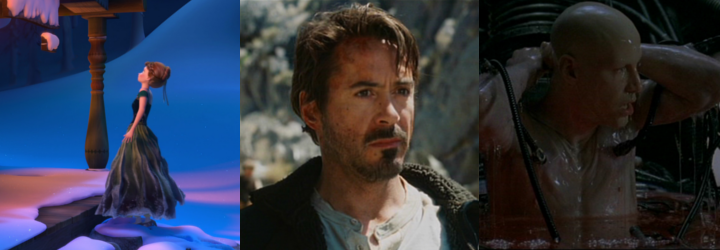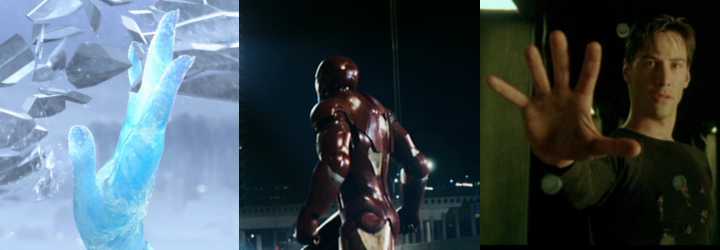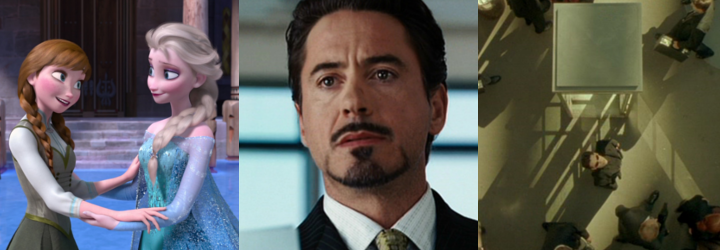The Hero's Powerpoint
01 Mar 2015What makes a good story? It turns out that, even among stories about very different things (romance, aliens, animated fluffy critters saving the world) there are some elements that are often the same. This topic is fascinating in its own right, but I find that it is also of great help for preparing academic talks. The goals of a talk (to keep the listener engaged and excited) are the same as those of a storyteller, and so it can be helpful to borrow some tips from the successful stories of the past few thousand years.
The idea of a repeated story structure that has existed since antiquity (the “hero’s journey”) was first popularized by Joseph Campbell, and then later championed by Chris Vogler. What follows is my personal summary of the major parts of this framework, as an amateur cinephile. I’ve illustrated each part with images from Frozen, Iron Man, and The Matrix, which all stick closely to this formula.
Structure of the journey
The ordinary world
 We’re introduced to the protagonist’s typical life. Things have been going the same way for some time, and the world is familiar. However, there are some questions or tensions lurking beneath the surface.
We’re introduced to the protagonist’s typical life. Things have been going the same way for some time, and the world is familiar. However, there are some questions or tensions lurking beneath the surface.
The breaking point
 The minor or unseen issues in the world burst to the forefront, disrupting the protagonist’s world in a catastrophic way. Life can no longer continue as it has in the past.
The minor or unseen issues in the world burst to the forefront, disrupting the protagonist’s world in a catastrophic way. Life can no longer continue as it has in the past.
Into the wild
 As a result, the hero is forced out into an unfamiliar world (physically or metaphorically). Their previous expertise and relationships are useless here, and they have no clear plan of action.
As a result, the hero is forced out into an unfamiliar world (physically or metaphorically). Their previous expertise and relationships are useless here, and they have no clear plan of action.
The mentor
 The protagonist meets someone in the wild who begins to guide their path. This is someone that they never would have met in their ordinary world, and whose advice they might have previously dismissed. They begin to gain insight about themselves and their new environment.
The protagonist meets someone in the wild who begins to guide their path. This is someone that they never would have met in their ordinary world, and whose advice they might have previously dismissed. They begin to gain insight about themselves and their new environment.
Formulating the plan
 With the mentor’s help, the protagonist understands their final goal and formulates a plan to achieve it. They often embark on this quest alone, without the mentor’s help, but with new knowledge gained from their time in the wild.
With the mentor’s help, the protagonist understands their final goal and formulates a plan to achieve it. They often embark on this quest alone, without the mentor’s help, but with new knowledge gained from their time in the wild.
The failure of the plan
 Despite their careful planning, the plan fails. The hero was missing critical information, about their own abilities or the loyalties of their supposed allies. All appears lost, the hero is dead or near death, and the final goal appears impossible to recover.
Despite their careful planning, the plan fails. The hero was missing critical information, about their own abilities or the loyalties of their supposed allies. All appears lost, the hero is dead or near death, and the final goal appears impossible to recover.
Seizing the sword
 Miraculously, the hero is able to recover and continues the fight. A new plan is put into action, and the protagonist discovers new sources of strength. The enemy is defeated and goal achieved, albeit at great cost.
Miraculously, the hero is able to recover and continues the fight. A new plan is put into action, and the protagonist discovers new sources of strength. The enemy is defeated and goal achieved, albeit at great cost.
The return
 The hero returns to their ordinary world reborn, and we see the consequences of their quest. The old stability is replaced with a new one, and the hero sees old relationships in a new light.
The hero returns to their ordinary world reborn, and we see the consequences of their quest. The old stability is replaced with a new one, and the hero sees old relationships in a new light.
Why we love the journey
This story structure is so common because it has a number of nice features that help keep the audience engaged:
- Background information is only required at the beginning. In order to follow the story and empathize with the hero, we need to be able to understand their feelings and actions. Doing this in the “ordinary world” is difficult, since the hero knows many things that that the audience does not know. By clearly designating that most of the story takes place in unfamiliar territory, we share the hero’s confusions and assumptions, and the audience doesn’t need to be constantly brought up to speed.
- There is a clear call to action. The problem faced by the hero is brought sharply to a breaking point, and there is no choice but to face it. Keeping things as they are is literally not an option.
- Help from an unlikely source. There are always “typical” ways of dealing with problems, such as just getting a bigger army or working harder. The mentor teaches an entirely new approach that runs counter to traditional wisdom in some way.
- The quest is near impossible. The failure of the hero’s plan emphasizes that the problem being solved is extremely difficult, and that even with all their new knowledge and training they couldn’t do it on their first try. When they do accomplish the task, it’s only through some incredible force of will.
- The story has a impact beyond the protagonist. The stakes go beyond the selfish desires of the hero, and the ordinary world is no longer the same after the events of the story.
Takeaways for presentations
If we want to make a talk into a good story, we should respect these same rules. Specifically:
- Background information needs to be given up front, and limited to what is strictly necessary. The audience needs to understand the current landscape as quickly as possible, and the rest of the talk should be new information that you are adding to the field.
- Talks need to have as sense of urgency - it’s not enough that something simply hasn’t been studied before. Why is there an immediate, desperate need for a breakthrough in this area?
- It’s more interesting when insights come from a surprising source, such as a disconnected field or forgotten research from the past. What did you bring to the table that no one has previously tried?
- Talks shouldn’t shy away from showing how difficult a result was to achieve. For example, if presenting a complicated system you engineered, walk the audience through your thought process - what did you try first, and why did it fail? Problems that can be solved on the first try are generally not that interesting.
- Spend time in your conclusion talking about the impact of these results on the field in general. How does this change the way people have been thinking about a problem, or enable a new line of research?
Of course not all talks can use all of these elements, and this is only a starting point (since it says nothing about how to communicate the specific technical content). But we should all strive to take the audience on a journey with us during our presentation - make it an exciting one!
Comments? Complaints? Contact me @ChrisBaldassano